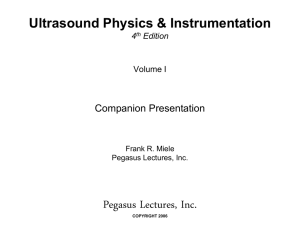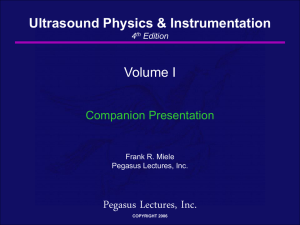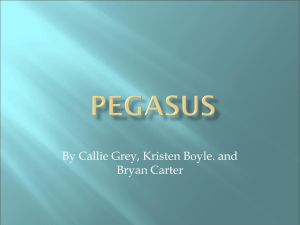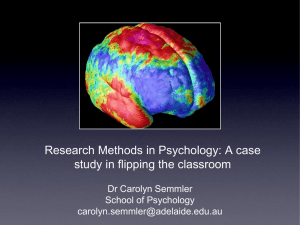SPIinNutshell
advertisement
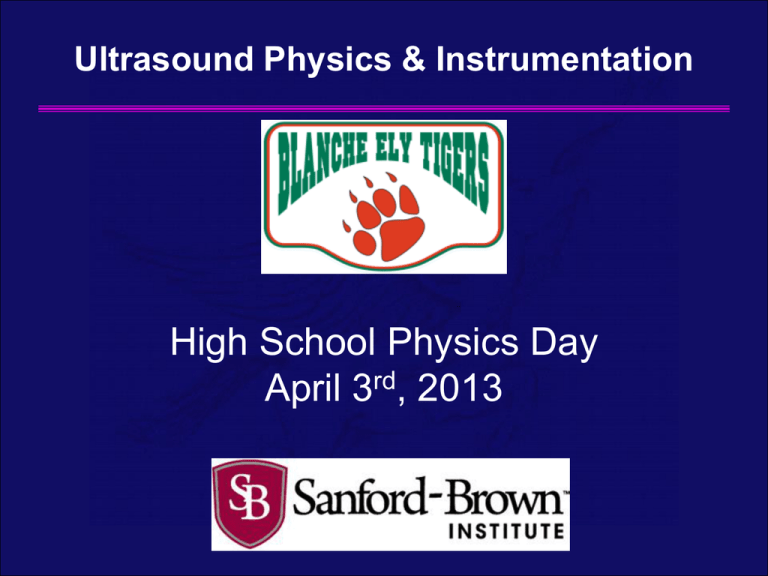
Ultrasound Physics & Instrumentation High School Physics Day April 3rd, 2013 “SPI in a Nutshell” Disclaimer: This is an overview of some important concepts in ultrasound medical imaging intended for high school physics students. It is intended to spark student interest in physics and the myriad of applications of physics, including medical ultrasound. This is not a complete introduction to medical ultrasound – there are many important topics not mentioned due to time constraints. Some slides are based on Pegasus Lectures, copyrighted material. Pegasus Lectures, Inc. COPYRIGHT 2006 “SPI in a Nutshell” Outline Basic Physics Overview Wave physics Transducers Piezoelectric crystals Instrumentation Overview From pulses to images Attenuation and Some Example of Imaging Artifacts Signal-to-noise ratio Doppler and Hemodynamics Bioeffects Mechanical and thermal indexes Metric Abbreviations Think about how much easier the metric system is than the English system; all you have to do is move the decimal point by the number of places specified by the exponent. G M k h da d c m m n = 109 = 106 = 103 = 102 = 101 = 10-1 = 10-2 = 10-3 = 10-6 = 10-9 1,000,000,000 1,000,000 1,000 100 10 0.1 0.01 0.001 0.000001 0.000000001 Pegasus Lectures, Inc. COPYRIGHT 2006 Distance Equation Distance rate time We will begin by calculating the time it takes for sound to travel 1 cm in the body (assuming a propagation velocity of 1540 m/sec). Since we want to solve for time, we must rewrite the equation in the form time = distance/rate. distance time rate 1 cm 1 10 2 m so time = 6.5 10 6sec 6.5 m sec m m 1540 1540 sec sec So it takes 6.5 msec to travel 1 cm or: 13 msec to image a structure at 1 cm because of the roundtrip effect. Pegasus Lectures, Inc. COPYRIGHT 2006 Distance Equation 6.5 m sec 1 cm 6.5 m sec 0 cm Time Distance Imaging Depth 6.5 msec 1 cm 0.5 cm 13 m sec 2 cm 1 cm 26 m sec 4 cm 2 cm 39 m sec 6 cm 3 cm 52 m sec 8 cm 4 cm 65 m sec 10 cm 5 cm 78 m sec 12 cm 6 cm 91 m sec 14 cm 7 cm 104 m sec 16 cm 8 cm 117 m sec 18 cm 9 cm 130 m sec 20 cm 10 cm Pegasus Lectures, Inc. COPYRIGHT 2006 Time of Flight in the Body Fig. 3: Imaging 1 cm Requires 13 msec (Pg 39) Pegasus Lectures, Inc. COPYRIGHT 2006 Addition of Waves 2 1 1 0.75 -0.5 0.5 0 0 0.25 0.5 Constructive Interference -1 -1.5 -2 Time (sec) 1 0.75 0.5 Sum = 0 1 0.75 -0.25 0.5 0 0 0.25 0.25 Destructive Interference -0.5 -0.75 -1 Time (sec) 2 1.5 1 1 0.75 -0.5 0.5 0 0.25 0.5 0 Amplitude Amplitude Amplitude 1.5 -1 -1.5 -2 Time (sec) Pegasus Lectures, Inc. COPYRIGHT 2006 Partial Constructive Interference Wave Propagation Classification Mechanical waves are further classified according to how they propagate. Fig. 2: (Pg 84) Pegasus Lectures, Inc. COPYRIGHT 2006 Transverse Wave Propagation Transverse waves propagate by particle motion that is perpendicular or “transverse” to the wave propagation direction. Fig. 3: Transverse Waves (Pg 85) Pegasus Lectures, Inc. COPYRIGHT 2006 Longitudinal Wave Propagation Longitudinal waves propagate by particle compression and rarefaction that results in particle motion that is “along” or in the same direction as the wave propagation direction. Fig. 4: (Pg 85) Pegasus Lectures, Inc. COPYRIGHT 2006 Wave Characteristics As sound propagates, it causes mechanical changes in the medium Frequency : 1 f Hz = and Period ( T : sec ) sec Propagation Speed : c ( m/sec ) Wavelength : ( meters ) Amplitude : A ( Volts, or any units for acoustic variables ) Pegasus Lectures, Inc. COPYRIGHT 2006 Graphical Depiction of a 2 Hz wave Fig. 10: (Pg 93) Pegasus Lectures, Inc. COPYRIGHT 2006 Wavelength Equation The wavelength of a sound wave depends on both the frequency and the propagation speed. A higher propagation speed “stretches” out the wave. A lower frequency “stretches” out the wave. Pegasus Lectures, Inc. COPYRIGHT 2006 Propagation Velocity (c) In Level 1, we discussed the fact that sound was determined strictly by the properties of the medium. It is now important to discuss which properties of the medium affect the propagation velocity and how. The propagation velocity is related to the square root of the bulk modulus of the medium. The propagation velocity is inversely related to the density of the medium. modulus c Pegasus Lectures, Inc. COPYRIGHT 2006 Propagation Velocities in the Body Medium Propagation Velocity Air (25 degrees C) 347 m/sec Lung 500 m/sec Fat 1440 m/sec Water (25 degrees C) 1495 m/sec Brain 1510 m/sec “Soft Tissue” Average 1540 m/sec Liver 1560 m/sec Kidney 1560 m/sec Blood 1560 m/sec Muscle 1570 m/sec Bone 4080 m/sec Table 5: (Pg 121) Pegasus Lectures, Inc. COPYRIGHT 2006 Speed Error Artifact Example This speed error case results from a needle entering into a cystic structure. The needle appears bent giving rise to the name “broken needle” or “bayonet” sign. Fig. 17: (Pg 606) Pegasus Lectures, Inc. COPYRIGHT 2006 Relationship of intensity with Amplitude Power Amplitude Intensity area area 2 So if the amplitude is doubled, the power increases by a factor of four, resulting in an increase in intensity by a factor of four. Recall that voltage is a measure of amplitude. Pegasus Lectures, Inc. COPYRIGHT 2006 Same Frequency – Different Amplitude Fig. 33: (Pg 135) Pegasus Lectures, Inc. COPYRIGHT 2006 Attenuation Attenuation is a measure of how the medium affects the wave. Attenuation will be divided into three subtopics: Absorption Reflection Refraction Pegasus Lectures, Inc. COPYRIGHT 2006 Reflection – Acoustic Impedance The amount of reflection from a boundary is determined by the acoustic impedance mismatch. What this equation says is: the greater the acoustic impedance mismatch between mediums, the greater the amount of reflection. How much reflection would there be if z2 = z1? Pegasus Lectures, Inc. COPYRIGHT 2006 Transmission All of the energy at an interface between media must be conserved. Excluding absorption, this means that whatever energy does not reflect must transmit (continue on through the patient). Can you imagine why it is so important to not have too much reflection from any one interface? Pegasus Lectures, Inc. COPYRIGHT 2006 Refraction and Snell’s Law θtransmitted ctransmitted cincident Medium 2 Medium 1 θincident θreflected Pegasus Lectures, Inc. COPYRIGHT 2006 Range Specificity and a Very Short Pulse Fig. 2: (Pg 194) Notice that the echoes from each of the three mountains return at distinct times such that each mountain is resolved (range resolution). Pegasus Lectures, Inc. COPYRIGHT 2006 Foundational PW Drawing Revisited Fig. 25: (Pg 220) Pegasus Lectures, Inc. COPYRIGHT 2006 Scanned Modalities (Animation) (Pg 207 A) Pegasus Lectures, Inc. COPYRIGHT 2006 Creating a Frame & Acoustic Lines Each transmit burst or “pulse” represents the beginning of one acoustic line. Multiple acoustic lines constitute one frame (or an image). Transmit 1 Transmit 2 Transmit 3 Time Pegasus Lectures, Inc. COPYRIGHT 2006 Piezoelectric Effect Ultrasound transducers use the piezoelectric effect to convert electrical energy into mechanical energy and mechanical energy back into electrical energy. Electrical to acoustic transformation Acoustic to electrical transformation Pegasus Lectures, Inc. COPYRIGHT 2006 Piezoelectric Effect Fig. 2a Expansion Fig. 2b Contraction (Pg 235) Pegasus Lectures, Inc. COPYRIGHT 2006 Fig. 2c At Rest Lateral Resolution and Beamwidth The lateral resolution equals the lateral beamwidth dimension. If the beam is wider than the distance between two structures, the echo from both structures will overlap, making it impossible to distinguish between the two structures laterally. Lateral Resolution Beamwidth Fig. 14: (Pg 248) Pegasus Lectures, Inc. COPYRIGHT 2006 SNR (can ask SBI students about it) 307 A: Poor SNR 307 D: Poor Apparent SNR 307 B: Good SNR 307 E: Good SNR (Pg 307) Pegasus Lectures, Inc. COPYRIGHT 2006 307 C: Poor Apparent SNR 307 F: Poor Apparent SNR Relative Motion and Angle Notice that Observer A sees the opposite effect of Observer B. Observer B sees a compression in the wavelength (a higher frequency) whereas Observer A sees an elongated wavelength, (a lower frequency). The higher frequency is referred to as a positive shift, whereas the lower frequency is referred to as a negative shift. Fig. 6: (Pg 532) Pegasus Lectures, Inc. COPYRIGHT 2006 Fast Moving Plane (Animation) (Pg 522) Pegasus Lectures, Inc. COPYRIGHT 2006 Doppler Equation In Level 1, we expressed the Doppler equation in a simplified form, ignoring the angular correction of the cosine term. We can now add the angular correction of the cosine term as follows: f Dop 2 f o v cos c Where: f Dop Doppler shifted frequency (relative to transmit frequency ) v velocity of the sound source (target) cos angle correction = insonification angle (or angle to flow) c speed of sound Pegasus Lectures, Inc. COPYRIGHT 2006 Determining Flow Direction Notice in this example that the flow is not changing in direction or speed (constant velocity) yet the flow looks very different traversing the vessel. This appearance is the result of the changing angle to flow formed between the constant flow direction and the varying steering angle. Fig. 54: (Pg 576) Pegasus Lectures, Inc. COPYRIGHT 2006 Flow Direction: Case 3 (Animation) (Pg 580 C) Pegasus Lectures, Inc. COPYRIGHT 2006 Flow Conversion between Potential and Kinetic Energy Assuming no loss of energy to heat, as the flow accelerates, there is a decrease in potential energy and a compensatory increase in kinetic energy (transitioning from region 1 to region 2) As the velocity decreases (region 2 to region 3) the kinetic energy decreases and the potential energy increases back to the same level as in region 1. PE PE KE PE KE KE Fig. 1: (Pg 742) Region 1 Lower Velocity Region 2 Higher Velocity Region 3 Lower Velocity Pegasus Lectures, Inc. Bioeffects Intensity Restrictions “Greatest Risk of Mechanical” B-Mode “Lowest Risk of Thermal” PW PW (larger gate) “Lowest Risk of Mechanical” CW “Highest Risk of Thermal” Pegasus Lectures, Inc. Basic System Functions Fig. 6: (Pg 308) Pegasus Lectures, Inc. COPYRIGHT 2006 American Registry of Diagnostic Medical Sonographers (ARDMS) • Must be registered sonographer (ARDMS or CCI) to practice in Florida • CCI exams easier than ARDMS • Two principal prerequisites to take ARDMS board exams: • Passing grade in ultrasound physics course http://www.ardms.org/credentials_examinations/ • Clinical experience (several months, duration depends on specific exam) http://www.ardms.org/files/downloads/Prerequisite_Chart.pdf Thank you! • • • Questions? If not, take your worksheet and follow SBI students to ultrasound lab You can find this presentation at my website: http://www.nhn.ou.edu/~blandon/ click on “SBI High School Physics Day”

